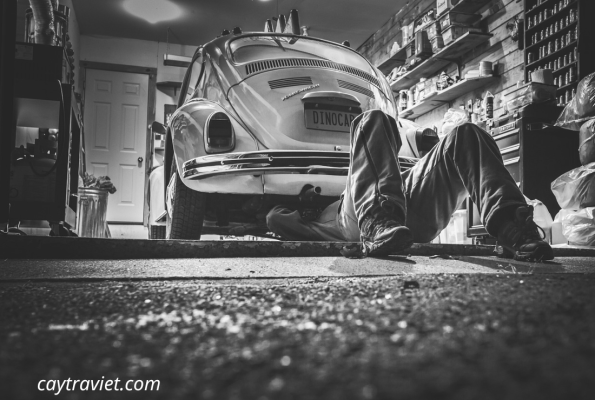When your vehicle starts showing signs of trouble, diagnosing the issue and addressing it promptly can prevent further damage and costly repairs. This guide will help you troubleshoot and fix common car problems by providing systematic steps to identify and resolve issues. Let’s dive in!
1. Engine Won’t Start
Possible Causes:
- Dead battery
- Faulty starter motor
- Fuel delivery issue
- Ignition system problem
Diagnosis and Fixes:
- Check the Battery:
- Symptoms: Clicking sound or no sound when turning the key.
- Action: Test the battery with a multimeter or jump-start the car. If it starts, replace the battery.
- Inspect the Starter Motor:
- Symptoms: No clicking sound, or a single click with no cranking.
- Action: Check connections and wiring. If the starter is faulty, it may need replacement.
- Fuel System Check:
- Symptoms: Engine cranks but doesn’t start.
- Action: Listen for the fuel pump. If it’s not working, check fuel levels and replace the fuel pump if needed.
- Ignition System Inspection:
- Symptoms: Engine turns over but doesn’t start or sputters.
- Action: Check spark plugs, ignition coils, and wires. Replace faulty components.
2. Overheating Engine
Possible Causes:
- Low coolant level
- Faulty thermostat
- Leaking radiator or hoses
- Malfunctioning water pump
Diagnosis and Fixes:
- Check Coolant Levels:
- Symptoms: Temperature gauge rising, steam from under the hood.
- Action: Add coolant to the reservoir. Check for leaks in the system.
- Inspect the Thermostat:
- Symptoms: Engine overheats after running for a while.
- Action: Replace the thermostat if it’s stuck closed.
- Check Radiator and Hoses:
- Symptoms: Coolant leaks or visible damage.
- Action: Inspect for leaks or cracks in the radiator and hoses. Replace damaged parts.
- Test the Water Pump:
- Symptoms: Whining noise or coolant leaks around the pump.
- Action: Replace the water pump if it’s not circulating coolant properly.
3. Strange Noises
Possible Causes:
- Worn belts or pulleys
- Exhaust system issues
- Suspension or wheel problems
- Engine or transmission issues
Diagnosis and Fixes:
- Inspect Belts and Pulleys:
- Symptoms: Squealing or chirping noises.
- Action: Check belt tension and look for cracks. Replace worn belts or pulleys.
- Examine the Exhaust System:
- Symptoms: Rattling or loud noises from underneath the vehicle.
- Action: Check for loose or damaged exhaust components. Repair or replace as needed.
- Check Suspension and Wheels:
- Symptoms: Clunking or banging noises when driving.
- Action: Inspect suspension components and wheel bearings. Replace worn or damaged parts.
- Listen for Engine or Transmission Noises:
- Symptoms: Knocking or grinding noises.
- Action: Check engine oil levels and transmission fluid. Consult a mechanic if the problem persists.
4. Poor Acceleration
Possible Causes:
- Clogged air filter
- Fuel system problems
- Ignition system issues
- Transmission problems
Diagnosis and Fixes:
- Replace the Air Filter:
- Symptoms: Sluggish acceleration and decreased engine performance.
- Action: Inspect and replace a dirty or clogged air filter.
- Check the Fuel System:
- Symptoms: Hesitation or sputtering during acceleration.
- Action: Inspect fuel filters, injectors, and pump. Clean or replace as necessary.
- Inspect the Ignition System:
- Symptoms: Misfiring or poor engine performance.
- Action: Check spark plugs, wires, and coils. Replace faulty components.
- Examine the Transmission:
- Symptoms: Slipping or jerking during acceleration.
- Action: Check transmission fluid levels. Consult a mechanic if issues persist.
5. Warning Lights on Dashboard
Possible Causes:
- Various issues depending on the light
- Common indicators include check engine, oil pressure, and battery lights
Diagnosis and Fixes:
- Check the Owner’s Manual:
- Symptoms: Warning lights illuminated.
- Action: Refer to the manual for specific information about the warning lights.
- Use an OBD-II Scanner:
- Symptoms: Various dashboard lights.
- Action: Connect a scanner to the OBD-II port to read trouble codes. Follow the recommended fixes based on the codes.
- Address Common Issues:
- Oil Pressure Light: Check oil level and pressure. Top up or change oil if necessary.
- Battery Light: Check battery and charging system. Replace the battery or alternator if needed.
- Check Engine Light: Consult a mechanic for detailed diagnostics.
6. Transmission Slipping
Possible Causes:
- Low transmission fluid
- Worn clutch (manual transmission)
- Faulty transmission components
Diagnosis and Fixes:
- Check Transmission Fluid:
- Symptoms: Slipping or erratic shifting.
- Action: Check fluid levels and top up if necessary. Ensure the fluid is clean and at the correct level.
- Inspect the Clutch:
- Symptoms: Difficulty shifting gears or slipping.
- Action: Check for clutch wear. Replace or adjust the clutch as needed.
- Examine Transmission Components:
- Symptoms: Grinding noises or poor shifting.
- Action: Consult a mechanic to inspect and repair internal transmission components.
7. Air Conditioning Issues
Possible Causes:
- Low refrigerant
- Faulty compressor
- Electrical issues
Diagnosis and Fixes:
- Check Refrigerant Levels:
- Symptoms: AC blowing warm air.
- Action: Use a refrigerant gauge to check levels. Recharge refrigerant if low.
- Inspect the AC Compressor:
- Symptoms: No cold air or unusual noises.
- Action: Check the compressor for proper operation. Replace if necessary.
- Examine Electrical Components:
- Symptoms: AC system not functioning.
- Action: Check fuses and relays related to the AC system. Replace faulty components.
Conclusion
Troubleshooting and repairing common car issues involves systematic checks and basic repairs. By following this guide, you can diagnose and address many problems yourself, saving time and money. However, for complex or persistent issues, it’s always best to consult a professional mechanic. Regular maintenance and prompt attention to problems will keep your vehicle running smoothly and efficiently.



